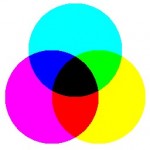Infinate Colors
I may have used affiliate links for some of the items in this post. Using an affiliate link to purchase an item won't cost you any more money, but I may receive payment if you click on a link and make a purchase. For more information, visit the disclosures page.
Who wants to read an old speech from college? It’s about color theory…. you know you want to read it!
Did you know that in theory there really are an infinite number of colors? Unfortunately, this theory means that it’s impossible to create every color; however print technology is always increasing, allowing people to create even more colors. Most people don’t even realize how greatly their lives are affected by theories of color and print technology. Especially how print technology has developed and improved over the years – you can even see where it has come by visiting sites like Duplo International. It really is quite amazing, and to think where we could be in a decades time. If you’ve ever purchased something, looked at a billboard or even read a book then your life has been touched by color theory and print technology. I have been doing research on the subject for most of my life by way of lessons in art, where I started learning color theory at a young age up until now where I am currently in a major where the uses of these theories along with their effects on print technology are very important. So today I would like to talk to you about color theory and how it affects print technology.
Color theory is a general term used to describe a wide range of things such as color development and mixing. These theories about color are always changing. Over the centuries color theory has developed from the basic Newtonian tri-color system consisting of the three primary colors Red, Yellow and Blue developed by Isaac Newton in 1665, to Goethe’s 6 color system including the secondary colors Orange, Green and Purple. This 6 color system is the basic system that you were taught in grade school. However artists have been using 12 shade color wheels for centuries. This allowed the artist to pick “harmonious” colors. In recent years there have been many advances in color theory. One of the most important advances was made by Michael Wilcox, who has done over 20 years of research on the subject. In “Concept of Color” from the September 25th, 2003 Issue of Printing World “Wilcox states that primary colors do not exist in true form, and secondary colors are not actually produced through mixing.” Therefore, Wilcox has created a color system based on the primary and secondary colors in which there are 2 shades of each primary color. Each of these 2 shades will lean toward one of the secondary colors, such as Red-Orange and Red-Purple.
These recent advances have greatly affected print technology.
According to Professor Ross, one of my professors during my time at Purdue, images that are created for print always tend to look “too perfect” or, they will not look good at all. This is largely due to fact that the process of color mixing cannot create images which are exactly true to life. The use of Wilcox’s system is now beginning to be implemented in several European printing companies. According to the article “Concept of Color” from the September 25th, 2003 Issue of Printing World this will not only help printers with mixing colors, but it will also cut production costs because it will allow ink companies to produce 6 main colors in bulk as opposed to the current 3 and cut the amount of lesser used specialty inks down to metallic and florescent colors. Another advance in print technology is already on the market. According to the article **”Shades of Grey” from the November 2003 Issue of Computer Arts Magazine Hewlett Packard has introduced a printer containing 3 new inks. These inks are 3 different shades of grey which would allow the user to print around 79.2 million colors.
Like Wilcox’s process it will allow the printer to rely less on color mixing, however the shades of grey mean that it will have an important effect on mixing shades of color as opposed to the color values.


